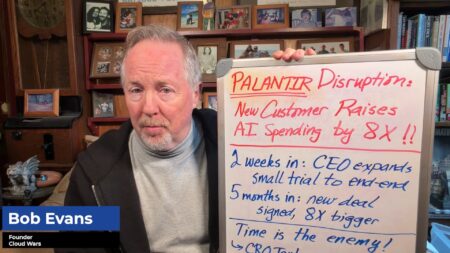As Oracle expands its Autonomous Cloud services and looks to claim a leadership position in cloud cybersecurity, CEO Mark Hurd said this week that 95 percent of cyberattacks are on databases that administrators have failed to patch for more than 9 months—and that Oracle’s Autonomous Database can instantly drive that deeply alarming figure to zero.
“Our average database, if we put out a patch, it could take 8, 9, 10 months to get our entire on-premise base of databases patched,” Hurd told reporters at an Oracle “Media Day” at company headquarters earlier this week.
“That would change—if everybody had Autonomous Database, that would change to instantaneous,” Hurd said.
A moment later, he added, “Ninety-five percent of attacks are on databases that have patches available that have been available for more than 9 months. Ninety-five percent of them. It’s amazing.”
While Hurd did not cite a source for that 95-percent figure, it broadly echoes some figures presented by Oracle in February of this year at its CloudWorld event:
- 85% of breaches exploited system vulnerability where patch had been available for 12 months; vulnerability fixes lag discovery by 100-120 days (source: Source: Verizon DBIR, 2015; Kenna Security Remediation Gap Report, 2015; Ponemon Privacy & Security of Healthcare Data, 2016);
- 89% of organizations experience data breaches (source: same as above); and
- 86% of respondents to a different survey said they feel traditional security approaches won’t work in the cloud (source: Cloud Security: 2016 Spotlight Report).
So in that context, Oracle is making a massive bet on its ability to convince customers that its strategy of complementing its Autonomous Database with an entire set of complementary self-driving and self-patching PaaS services will be a major weapon for those customers in their escalating battles against cybercriminals.
On top of the significant security enhancements Oracle believes the Autonomous Database can deliver, Hurd also spoke bluntly about the cost-savings on labor that customers can expect when the self-driving software eliminates the need for database administrators to do the monitoring, testing, patching and tuning.
“There are hundreds of thousands—hundreds of thousands—of DBAs managing Oracle databases,” Hurd said.
“If all of that moved to Autonomous Database, that number would change to zero.”
In addition to the new database service, which has been available for several weeks, Oracle said it’s now offering autonomous PaaS services for applications development, analytics and integration.
In a press release describing those new services, Oracle executive vice-president Amit Zavery said, “These new cloud services are the latest in a series of steps from Oracle to incorporate industry-first autonomous capabilities that will enable customers to significantly reduce operational costs, increase productivity, and decrease risk.”
Here’s a look at how the company described each of those three new self-driving offerings:
Oracle Autonomous Analytics Cloud:
- Uses natural-language processing to allow mobile users to submit questions that deliver rich visualizations;
- uses machine learning to gain intelligence and proactively suggest insights; and
- provides predictive analytics on IoT data using domain-specific machine learning and historical patterns of failure.
Oracle Autonomous Integration Cloud
- Integrates multiple Oracle and non-Oracle SaaS and on-premises applications by using machine learning and automated application integration;
- uses crowd-sourced data of all executed integrations and machine learning to display how to connect relevant objects;
- provides APIs and suggests next-best actions; and
- for systems that lack APIs, enables “Robotic Process Automation” to automate “the last mile of case management or process automation.”
Oracle Autonomous Visual Builder Cloud
- Uses no-code technology to allow business users and developers to rapidly develop and deploy mobile and web apps;
- automates code generation to help business users create basic apps; and
- automates delivery of mobile apps across multiple platforms including iOS and Android.
These moves by Oracle, and its overall commitment to delivering a full autonomous Cloud Platform by the end of the year, give the company a unique PaaS position in the wickedly competitive enterprise-cloud marketplace.
To date, Oracle’s big winner in the cloud is its SaaS business, which in the last 12 months generated almost $5 billion in revenue, while its combined revenue for PaaS and IaaS was about $1.2 billion over that time.
If the company’s Autonomous Database can deliver on the big promises the company has been making about it, then it’s quite possible Oracle can extend its market leadership in on-premises databases into the cloud.
But Oracle better move fast because every major cloud company that’s not cloud-native—Microsoft, IBM, and SAP—is gunning for that same high-value spot in the Cloud Wars.
*******************
RECOMMENDED READING FROM CLOUD WARS:
The World’s Top 5 Cloud-Computing Suppliers: #1 Microsoft, #2 Amazon, #3 Salesforce, #4 SAP, #5 IBM
Amazon Versus Oracle: The Battle for Cloud Database Leadership
As Amazon Battles with Retailers, Microsoft Leads Them into the Cloud
Why Microsoft Is #1 in the Cloud: 10 Key Insights
SAP’s Stunning Transformation: Qualtrics Already “Crown Jewel of Company”
Watch Out, Microsoft and Amazon: Google Cloud CEO Thomas Kurian Plans To Be #1
The Coming Hybrid Wave: Where Do Microsoft, IBM and Amazon Stand? (Part 1 of 2)
Oracle, SAP and Workday Driving Red-Hot Cloud ERP Growth Into 2019
*********************
Subscribe to the Cloud Wars Newsletter for twice-monthly in-depth analysis of the major cloud vendors from the perspective of business customers. It’s free, it’s exclusive, and it’s great!








